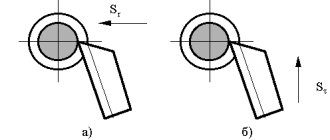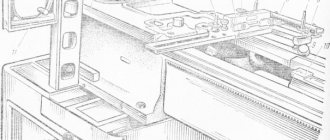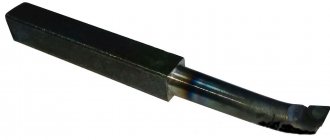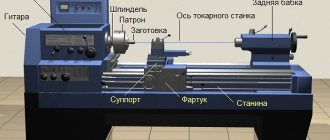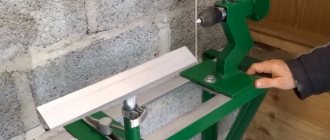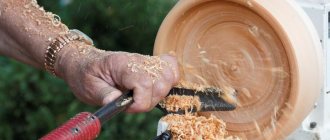Types of steady rests for lathes
Steady rests for lathes come in different types. In addition to differences in structural elements, sizes, types of mounting on the frame, all tools without exception can be classified into one of two main categories:
Read also: How to read a topographic map
- Lathe lunettes, which are called stationary. They are installed permanently at any working point and remain there during the entire processing cycle.
- Devices that are called movable. Their location on the bed changes depending on where the turning tool moves along the workpiece.
Steady rests for a grinding machine have a similar design to the stationary fixtures of a lathe. Their supporting parts are coated with a material that does not allow the grooves on the workpiece to be wiped, such as babbitt.
Fixed lunette
A fixed steady rest is a device for a lathe, the purpose of which is to support a long workpiece. This allows for more precise processing of the product and eliminates vibration. The method of attaching the equipment to the frame is through a flat base plate and a bolted connection.
A characteristic feature of all fixed turning steady rests is the presence of three rollers, or cams, two of which support the part from below, the third provides support from above. In order to install the workpiece on the fixture, the upper part of the latter can be hinged, and after securing the part, it returns to its place and is fixed with a special bolt. The design of fixed turning equipment fully corresponds to the design described in the section “Design and purpose of the steady rest.”
As a rule, in a stationary lathe rest the blank is fixed as rigidly as possible. This is due to the fact that the processing in this case is mainly rough.
Lunette of movable design
A movable steady rest is a slightly different support design than a fixed device. It is no longer attached to the frame, but to a longitudinal support on a lathe. This allows the system to move simultaneously and in the direction in which the cutting tool is moving. That is, it is located opposite the incisor itself. The main purpose of a movable turning rest is to eliminate bending of thin and long parts under the influence of a cutter. This allows you to avoid jamming of the tool and damage to the product.
DIY lunette
Design, principle of operation and purpose of the electroscope
Many home craftsmen have lathes for processing metal and wood. And, faced with the problem of turning long parts, they ask themselves: how to make a homemade steady rest?
First, you need to find on the Internet and download a drawing of the original design designed for the type of equipment used. To make a steady rest for a lathe with your own hands, you need to select the material. While wood is sufficient for a woodworking machine with minimal loads, steel blanks are required for a metal-cutting lathe.
Factory models are made of cast iron and have significant weight. Homemade designs will be lightweight. A profile pipe or steel sheet of sufficient thickness is used.
A base with an internal hole is cut out of the sheet, the diameter of which should be slightly larger than the parts being processed. The pressing elements are made of thicker-walled material. The screw pair for supplying supports can be replaced with sliding elements. But they must have guides and reliable clamping with a bolt and nut.
Many people use a roller from roller skates or simple rolling bearings as rotating support elements. After manufacturing the structure, it must be centered relative to the processing axis. Any significant displacement will result in structural failure.
A steady rest for a wood lathe can perform a dual function. The first is the support of the wooden workpiece. The second is to use it as a tailstock. After external turning is completed, the tailstock is removed and the end is fixed in the rest.
There is free access to the end of the workpiece and internal boring can be done.
Whatever the steady rest, it must contain three support points located in a circle at 120° intervals. This ensures the necessary clamping of the workpiece. After making a homemade structure, it must be checked.
Initially, the positions are checked: perpendicularity to the bed and parallelism to the machine chuck. Then a dynamic test is carried out with a rotating part. First, the minimum speed is set, and then the speed gradually increases to the maximum.
Machining non-rigid parts
When working on a lathe, it is often not possible to achieve the desired result when using parts whose length exceeds 10-12 times the diameter in combination with traditional clamping methods. This drawback can be eliminated by additional fastening of the part. Steady rests for lathes allow you to solve this problem. It should be noted that steady rests are different and have their own characteristics in terms of working with them.
Fixed rests for lathes and their use
The location of the fixed steady rest is the machine bed, and a bolt and a strip are used as a clamping element. There are several main elements in the body of this device:
- base;
- a cover that is attached to the base using a hinge.
In order to be able to fix the cover in the working position, a hinged bolt with a shaped head is provided. A design feature of a steady rest for lathes is the presence of three cams, of which two are located at the base, and another one is on the cover. Such cams provide the possibility of changing their position in holes made in the body, which is done using adjusting bolts. To fix the cams in the required position, use the appropriate screws.
The traditional material for steady rest cams is cast iron. If working conditions create the likelihood that the surface of the workpiece will be damaged as a result of friction against the jaws, then it would be useful to add protection in the form of bronze tips to the steel jaws. An alternative to this solution could be cams, the working surface of which has a special coating based on babbitt. In cases where the cams are expected to wear too quickly , protection of the working surfaces is provided by a hard alloy coating created by welding. They can be replaced with steady rests for lathes, in which the cams have built-in rollers.
Movable steady rest and its structure
This device is located on the longitudinal support of the machine. Thanks to this arrangement, the mobile steady rest performs movements with the same trajectory as the machine cutter. Thus, the pressure on the part from the turning tool is reduced. The movable type of device also has its own classification:
- According to the clamp system. There are roller and cam fixation systems. Fastening with rollers ensures convenient sliding of the workpiece during work, while cams provide better control over the position of the part.
- According to the specifics of processing. Different types of tools can be used for grinding, turning or creating bearings.
- By type of clamp settings. In these devices, the cams or rollers can be adjusted manually or using a hydraulic drive.
- By the number of fasteners. Most devices are manufactured with three cams, but there are models with more clamps.
The mobile steady rest is attached to the support carriage and is used in cases where there is a need to perform clean turning or make threads on long workpieces. Like a fixed steady rest, thanks to adjustable cams, it has the ability to fix parts of completely different diameters.
The maximum diameter of the workpiece being processed depends on the device model and ranges from 20 to 250 mm. Key elements of the movable steady rest design:
- Hinged lid.
- Blank for processing.
- Pads.
- Screws for installation.
- Frame.
Before starting work on the part, it is necessary to grind the area in which it will come into contact with the steady rest clamps. The jaws must be clamped smoothly and slowly for secure and even clamping. With proper fixation, the workpiece will remain motionless even under very heavy loads. After completion of the work, the cams are gradually retracted or the cover of the device is opened.
Advantages and disadvantages of the device
A correctly installed steady rest significantly improves the accuracy of the work performed, ensures the integrity of the part, facilitates the operator’s work and ensures safety. The device expands the maximum and minimum parameters of the workpieces being processed, and also provides additional angles for fastening parts. The device is reliable and easy to use.
A mobile steady rest is easier to install, while a fixed one provides greater accuracy. It is necessary to begin work by carefully checking the fixation of the workpiece. You should pay attention to the fit of the cams.
Design of a movable steady rest
The movable steady rest is located on the longitudinal support of the machine. This position allows him to perform movements in a trajectory similar to the movement of the machine cutter. This reduces the pressure exerted on the part by the turning tool. The movable type of device also has its own classification:
- According to the clamping system, cam and roller fixation systems are distinguished. With the help of a cam fastening, better control over the position of the part is provided; a roller fastening helps the workpiece slide comfortably when performing work;
- according to the specifics of processing: different types of devices are used for turning, grinding, and creating bearings;
- by the number of clamps: generally such devices are produced with three cams, however, there are models that have a larger number of clamps;
- by type of clamp settings: . The cams or rollers in these devices can be adjusted using a hydraulic device or manually.
The mobile steady rest is attached to the support carriage. It is used when it is necessary to make threads on cams or perform clean turning. Thanks to adjustable cams, a mobile steady , like a stationary one, can fix parts of completely different diameters.
The largest diameter of the workpiece being processed ranges from 20 to 250 mm and depends on the device model. The main elements of the design of a movable steady rest:
- hinged lid;
- workpiece for processing;
- frame;
- pads;
- workpiece for processing.
Before you start working, you need to grind the area on the part where it will touch the latch. The jaws should be clamped slowly and smoothly for proper and secure clamping. If the fixation is done correctly, the workpiece will remain motionless even under heavy loads. Having completed the work, the cams gradually retract and open the cover of the device.
What types of steady rests are there, their design
The device is used when it is necessary to avoid the risk of damage and deformation of the product or cutting elements of the machine by giving the workpiece additional stability, in some cases, to allow the part to be processed from the end. Devices can be either movable or fixed.
Fixed lunette
This type of mechanism is designed to provide support for large, long parts during processing. It is attached to the area of the lower gearing of the machine stationary and motionless. The result of use is a reduction in beats and vibrations, an increase in processing accuracy. The fixed steady rest consists of:
- A base that is directly attached to the machine using a special bolt;
- Covers connected to the base by means of a hinge;
- Lid clamp to the base;
- Retractable cams or rollers (usually there are three);
- Mechanisms for feeding and fixing cams.
In some cases, the first two elements may act as a single structure.
Since the cams have direct contact with the surface being processed, the latter may be damaged at the point of contact. To prevent this, there are bronze tips at the ends of the stops. The cams themselves are made of hard alloys so that they can withstand severe dynamic loads. Retractable rollers have less impact on the workpiece in terms of damage.
Lunette of movable design
A movable turning rest is installed on the machine, on its longitudinal support, and secured to the carriage. It can be moved freely along this support in the same way as a turning tool moves. The device can be used for different diameters of products. The result of use is that the turning cutter exerts less pressure on the surface, the processing is more uniform, and the risk of destruction of the cutting element is eliminated.
Apart from the attachment system to the machine, all other elements of the movable steady rest are similar to the fixed fixture. There is a certain classification of movable type devices for lathes:
- By type of workpiece holding elements – cam clamps, clamps with built-in rollers;
- For various part processing operations - for grinding, for turning, for the manufacture of bearings;
- By the number of retractable stops - with three or more fixing elements;
- Depending on the system for adjusting the clamps - mechanically, manually, hydraulically, automatically.
How to install and adjust the support fixture
The steady rest is installed only in the place where the workpiece has a strictly cylindrical shape or has been pre-treated in the presence of deformations.
The base of the device is bolted to the machine. The first step is to adjust the lower supports. The part must lie horizontally on them, which is checked with a measuring device along its entire length.
If there is sagging in a workpiece of small diameter, it is raised to the required height using the moving mechanisms of the lower supports.
Next, using the upper support, the part is fixed and centered. After the adjustments are completed, torque is created without supplying the cutter. The presence of beats (vibrations) is checked. Only after a thorough check can you begin to work.
When processing long workpieces on a lathe, it is simply necessary to use a steady rest. It can have a different design depending on the type of machine and the type of part.
When choosing a device, you need to pay special attention to its technical characteristics and the strength of the materials used.
Recommendations for use
Before purchasing or using the device, you need to familiarize yourself with the following important points:
- The place where the clamp comes into contact with the part is ground only during rough work. If the workpiece has a fixed size or its surface has already been processed, there is no need to carry out preliminary turning;
- in case of finishing work and the need for reliable fastening of the part, you can use a special roller - a cylindrical pad. It should be the same diameter as the diameter of the workpiece where it connects to the jaws. One part of the lining is fixed in the device, the other in the machine chuck;
- When working with long and thin parts , it is not always possible to pre-turn the neck. In such cases, several temporary necks should be made, with the closest approach to the headstock;
- It is better to set the machine cutter with a negative angle , otherwise it may push the part away from itself. As a result, processing accuracy will decrease.
